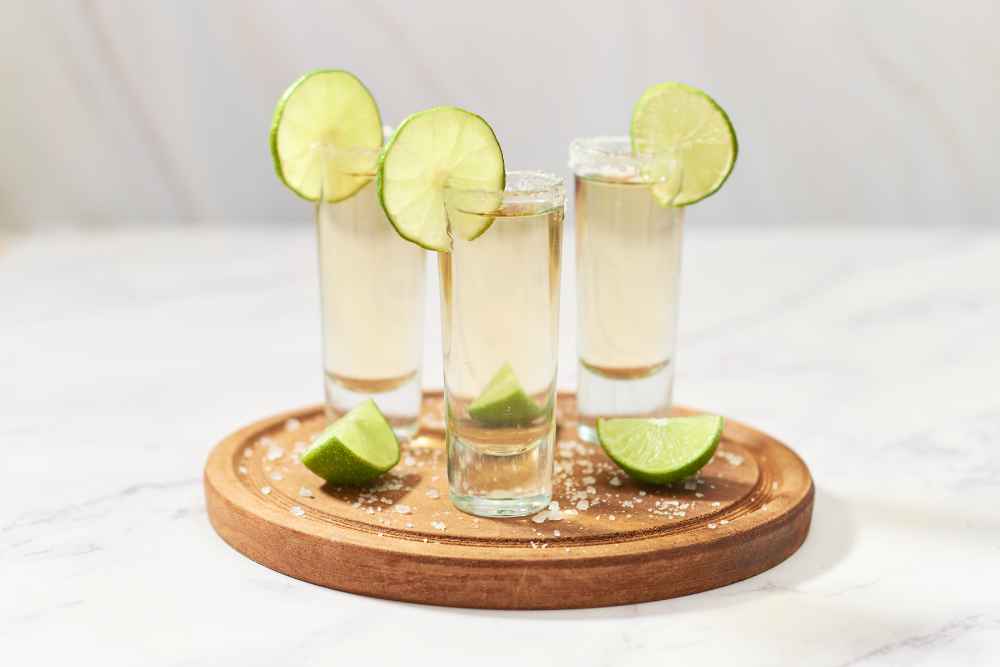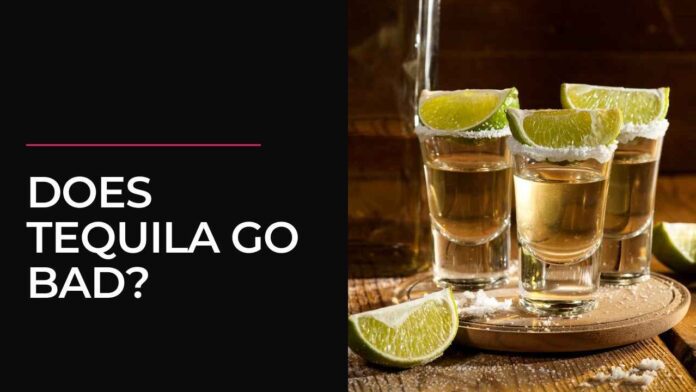This page may contain affiliate links. Please see our Disclaimer for more information. Always drink responsibly and adhere to your local legal drinking age.
Introduction
There’s nothing quite like sipping on a refreshing tequila cocktail to beat the heat or liven up a party. But have you ever wondered if this Mexican spirit has an expiration date? Whether you’re an enthusiastic mixologist or enjoy the occasional shot, knowing how long tequila lasts and how to store it properly is essential.
In this blog, we’ll explore whether tequila goes bad, what signs indicate spoilage, and how to preserve its quality for as long as possible.
Key Takeaways:
- Tequila can go bad if not stored properly, with exposure to light and heat being the main culprits.
- Unopened bottles of tequila can last for years when kept in a cool, dark place, while opened ones should be consumed within six months but may still retain their taste for longer if sealed tightly.
- Signs that your tequila has gone bad include changes in color, unpleasant smell or taste, and debris in the bottle.
- Properly storing your tequila is crucial to keeping it fresh and ensuring a great drinking experience. Follow simple storage guidelines, such as keeping it upright and away from direct sunlight and heat sources.
Understanding Tequila

The Blue agave plant is the key ingredient in tequila, which goes through a fermentation and distillation process to become the popular Mexican spirit.
The Distillation Process
The distillation process is a crucial step in creating the tequila enjoyed by cocktail drinkers worldwide. It begins with harvesting the blue agave plant, which typically grows for at least seven years before reaching optimal maturity.
Fermentation comes next, as these sugars are transformed into alcohol through the addition of yeast. This process can take anywhere from three days to several weeks, yielding an agave-based beer called “mosto.” The mosto then undergoes double-distillation in copper or stainless steel stills – first as ordinary distillate (less potent) and then again as high-proof distillate (more potent).
These two stages ensure that impurities are removed while preserving tequila’s unique flavors and aromas derived from its blue agave origins.
Aging And Quality
Aging plays a critical role in the quality of tequila, as it undergoes a maturation process that significantly impacts its flavor profile. There are three main types of aged tequilas to consider: Reposado, Añejo, and Extra Añejo.
Reposado is aged for at least two months but less than a year; this imparts subtle oak flavors while retaining the vibrant agave taste. Añejo matures for one to three years in oak barrels, developing deeper hues and more pronounced woodsy notes with hints of caramel or chocolate.
Quality also largely depends on the type of agave used in producing tequila. Premium brands typically utilize 100% Blue Weber Agave plants from the Jalisco region in Mexico, which yield top-notch spirits revered by connoisseurs worldwide.
Conversely, lower-quality “Mixto” tequilas may contain added sugars and additives during fermentation that can adversely affect both taste and potential health effects when consumed irresponsibly.
Does Tequila Go Bad?
Tequila can go bad, but it depends on how it’s stored.
Unopened Bottles
An unopened bottle of tequila, when stored properly, can last for years without going bad. This long shelf life is due to the high alcohol content found in tequila and other hard liquors such as vodka, whiskey, rum, gin, and brandy.
However, it’s crucial to keep these unopened bottles away from direct sunlight and heat sources to maintain their quality. For instance, consider Don Julio Blanco or Patron Silver as timeless additions to your bar inventory.
By storing them in a cool, dark place like a cabinet or cellar with consistent temperature conditions – you’ll be able to enjoy their delightful flavors through those special occasions for years to come.
Opened Bottles
Once you’ve opened a bottle of tequila, it’ll last indefinitely if properly sealed. The flavors and quality of the tequila may decline slightly after a few years, but it won’t go bad like other perishable foods.
To ensure that your tequila retains its authentic flavor and aroma for as long as possible, be sure to seal the bottle after each use tightly. If you have a lot of leftover tequila in an open bottle, consider transferring it to a smaller jar or container with limited air space to prevent oxidation.
Factors Affecting Tequila’s Shelf Life

Tequila’s shelf life is affected by various factors such as storage conditions, exposure to light and heat, oxygen, and evaporation.
Storage Conditions
To properly store tequila and prolong its shelf life, follow these simple storage guidelines:
- Keep it cool and dark: Store your bottle of tequila in a cool area away from direct sunlight and heat exposure, preferably in a cabinet.
- Store upright: To prevent evaporation or leakage, store your bottle of tequila upright rather than on its side.
- Avoid temperature fluctuations: Rapid changes in temperature can have a negative impact on the quality of tequila. Keep the bottle at consistent room temperature.
- Reseal properly: Properly seal the lid or cork after each use to minimize air exposure and slow down oxidation.
By following these simple steps, you can ensure that your tequila maintains its flavor and quality for years to come. Remember that unopened bottles of tequila can last up to five years when stored correctly, while opened bottles may begin to lose flavor after a few years but can still be consumed safely as long as they are properly sealed. Proper inventory management can help prevent waste and ensure that your tequila is always fresh and ready to use for your favorite cocktails like margaritas, Palomas, or Tequila Sunrise.
Exposure To Light And Heat
Exposure to light and heat is one of the biggest factors that can cause tequila to spoil. When tequila is exposed to direct sunlight or high temperatures, it can lead to the loss of flavor and change in color.
The UV rays from sunlight break down chemical compounds in the tequila, leading to oxidation and degradation of flavor.
To avoid this problem, store your tequila bottles in a cool dark place at room temperature, away from direct sunlight or any other heat source. You should also avoid storing opened bottles near windows or other areas where they might get exposed to light or fluctuating temperatures.
Oxygen And Evaporation
The exposure of tequila to air and oxygen can lead to oxidation, which affects its flavor and aroma. Once a bottle is opened, the level of liquid decreases, creating an area for air and oxygen to penetrate.
This can cause evaporation, leading to changes in the alcohol content and the concentration of flavors in the tequila. Properly sealing an opened bottle of tequila is crucial in prolonging its shelf life.
Additionally, storing it upright instead of laying it on its side can prevent prolonged exposure to air at any point along the cork or seal line.
Signs Your Tequila Has Gone Bad
Your tequila has gone bad if you notice a change in color, a sour or vinegary taste, sediments or debris in the bottle, an unpleasant smell, or damage to the bottle or seal.
Changes In Color
If you notice that your tequila has changed color, it may be a sign that it has gone bad. Tequila should have a clear or slightly yellowish hue, depending on the type and aging process.
However, exposure to sunlight or heat can cause it to change color and potentially go bad. For example, if you see brownish hues in your once-clear blanco tequila, the oxidation process has begun, and the agave sugars are breaking down.
Similarly, anejo tequilas aged in oak barrels can take on an amber or golden tint due to prolonged contact with wood tannins adding complex flavors; however, they might also develop overly strong oak and vanilla notes if barrel-aged for too long past their peak maturity phase.
Properly storing tequila in cool, dark places can help prevent changes in color and ensure it lasts longer.
Unpleasant Smell
Another sign that your tequila may have gone bad is if it has an unpleasant smell. Spoiled tequila can have a sour or off odor, indicating that it has oxidized or fermented beyond its shelf life.
It’s worth noting that adding mixers such as salt and lime may partially mask some of the off odors, but ultimately, they won’t completely eliminate the problem. Similarly, pouring spoiled tequila into cocktails could ruin the flavor profile of even the most expertly crafted drink.
Altered Taste
If you’ve noticed that your tequila doesn’t taste right, it might be an indication that it has gone bad. Tequila that has gone bad can have a sour or vinegary taste, a musty or moldy smell, and may even cause discomfort when consumed.
The best way to avoid experiencing this altered taste is by properly storing your tequila in optimal conditions, such as keeping it cool and in a dark place without exposure to light or heat.
Additionally, make sure you reseal opened bottles tightly after use to prevent oxygen from getting inside.
Sediment Or Debris
Sediment or debris in your tequila can be a clear sign that it has gone bad. When left out for too long, tequila can attract bacteria and other contaminants, leading to changes in its texture and flavor.
If you notice murkiness or sediment in your bottle of tequila, it’s best to avoid consuming it. Not only can drinking spoiled tequila cause nausea and vomiting, but it can also lead to unpleasant chemical reactions such as heartburn and stomach pain.
Damaged Bottle Or Seal
A damaged bottle or seal can be a potential cause of bad tequila. A broken seal can increase the risk of contamination, while a damaged bottle may allow air and light to penetrate through the cracks, causing oxidation and spoiling the liquor.
This is why it’s crucial to pay attention to the condition of your tequila bottles before purchasing them. Always make sure that they are properly sealed and stored in ideal conditions.
If you notice any damage to the bottle or seal after purchase, consider returning it as soon as possible to prevent consuming bad-quality tequila that can cause unpleasant reactions like stomach pain and heartburn.
How To Properly Store Tequila
To properly store tequila, keep it in a cool, dark place away from direct sunlight and high temperatures; store the bottle upright to prevent the cork from drying out and allowing air in; avoid temperature fluctuations by keeping it away from appliances or windows that produce heat or cold.
Keep It Cool And Dark
Proper storage of tequila is key to preserving its distinct flavors and aromas. To ensure that your tequila maintains its quality, it’s best to keep it cool and dark.
Direct exposure to sunlight or heat can cause the chemical compounds in tequila to break down, resulting in a loss of flavor.
One way to maintain an optimal temperature for storing tequila is by keeping it at room temperature in a cabinet away from direct light exposure. This will help protect the delicate balance of agave sweetness and spiciness found in different types of tequilas, such as Reposado, Joven, and Aejo.
If you plan on storing your bottle for extended periods, consider investing in a wine fridge or cellar which offers better climate control options than regular cupboards at home or bars.
Store Upright
Storing tequila upright is an important consideration when it comes to maintaining its quality over time. By keeping the bottle vertical, you can help prevent any interaction between the liquid and the cork that could cause unpleasant chemical reactions.
This will also keep your tequila from absorbing any odors from the surrounding area and altering its flavor profile.
It’s worth noting that other types of alcohol have similar storage requirements as well. For example, wine bottles should be kept on their side to ensure that the cork stays moist and doesn’t dry out, while spirits like vodka and whiskey are typically stored standing up like tequila.
Avoid Temperature Fluctuations
Tequila is a delicate spirit that can be affected by temperature fluctuations, which can cause changes in flavor and quality. Storing tequila at a consistent, cool temperature is vital to maintaining its distinct characteristics.
Keeping the bottle away from direct sunlight and extreme heat sources such as radiators or stovetops will help preserve its flavor profile. Remember to store it upright to prevent oxygen exposure through the cork or seal.
Experts recommend storing your favorite tequilas in a cool, dark place, similar to how wine lovers store their treasured bottles of reds and whites. Temperature fluctuations make shelf life unpredictable; therefore, placing your favorite liquors away from sudden spikes or drops of heat that may occur around cooking areas or places with high traffic movements, like countertops where people often serve cocktails during parties or happy hours, is advisable.
Reseal Properly
To ensure the longevity of your tequila, it’s crucial to reseal the bottle after each use. Oxygen can cause chemical reactions in the liquor, which can alter its flavor and aroma over time.
When you’re finished pouring a drink, make sure to seal the bottle tightly with the cork or cap that came with it.
If you have an unfinished bottle of tequila with only a small amount left inside, consider transferring it to a smaller container before sealing it shut. The less air space there is in the container, the slower oxidation will occur.
Remember that while properly sealed tequila may last indefinitely when kept under ideal conditions, such as in a cool dark place away from direct sunlight and temperature fluctuations, among others, storage does affect its shelf life, so do check periodically for any changes in color or smell – this could indicate spoilage or degradation in quality and should be avoided at all costs.
FAQ
In this section, we address some common questions that cocktail drinkers may have about tequila and its shelf life:
Can unopened tequila go bad?
Tequila can go bad if not stored correctly, leading to changes in flavor and color, even in unopened bottles.
How can I tell if my tequila has gone bad?
Spoiled tequila is usually brown or yellow and has a sour or off smell, as well as altered taste and sediment or debris in the bottle.
How long does an opened bottle of tequila last?
Opened bottles of tequila can last indefinitely if properly sealed, but the quality may decline after a few years.
Can I drink expired tequila?
Tequila won’t make you sick if consumed past its expiration date, but overconsumption of alcohol can be harmful.
What are the three main types of tequila?
There are blanco, reposado, and añejo tequilas, each with distinct flavors and characteristics.
Is tequila gluten-free?
Tequila is a low-calorie alcoholic beverage that those with gluten sensitivities can enjoy.
Why do people lick salt before drinking tequila?
Licking salt before drinking a shot of tequila is a common practice among many tequila drinkers as it enhances the flavor in a non-alcoholic way.
Conclusion
Tequila is a popular alcoholic beverage many enjoy, but it’s essential to understand how it can go bad. Properly storing tequila in a cool, dark place and sealing it tightly is crucial to maintain its flavor and quality.
While unopened tequila bottles can last for years, opened ones will only keep their taste for about six months.
Drinking bad tequila ruins your cocktail and can lead to stomach discomfort and other unpleasant side effects.



















